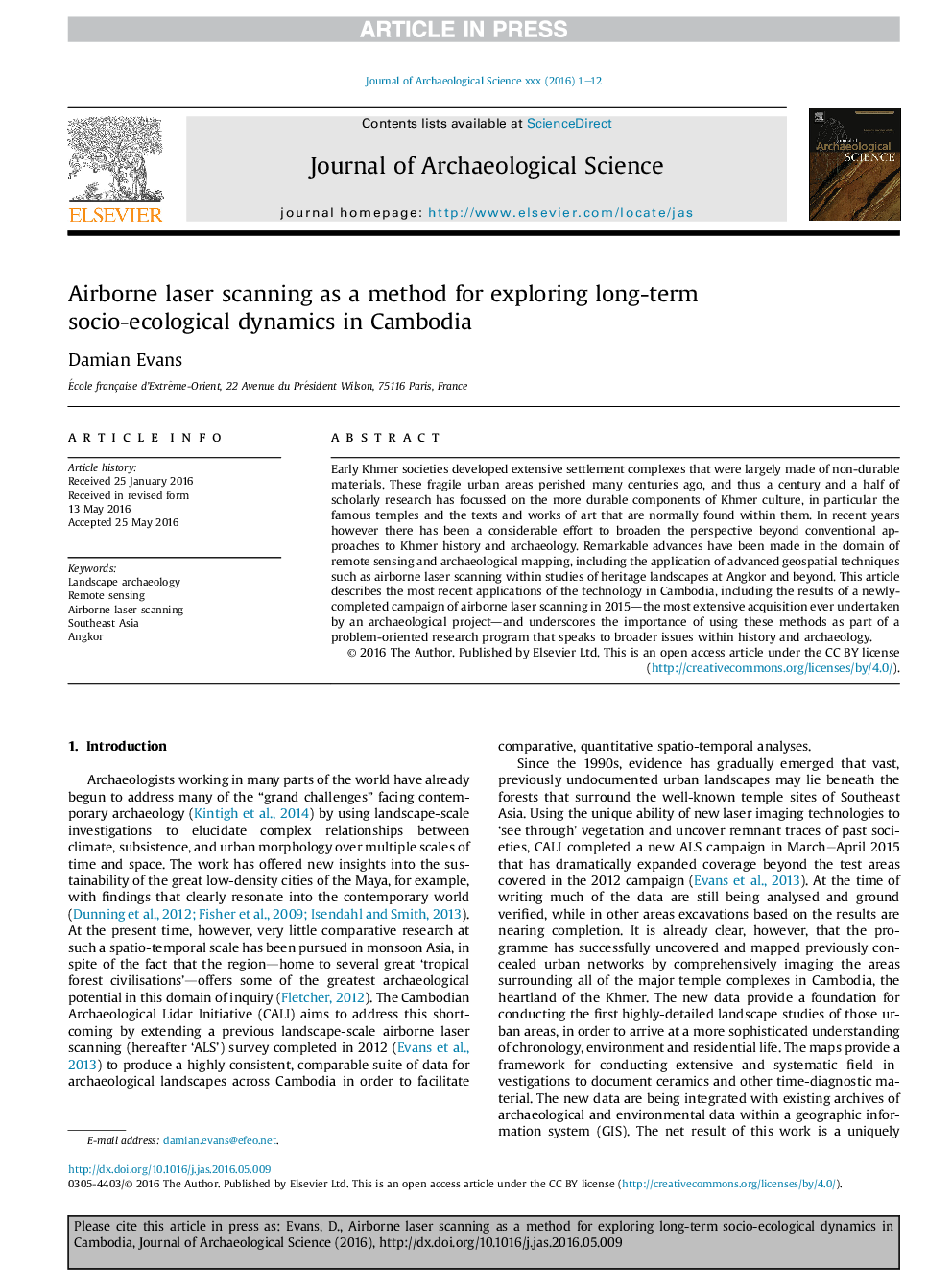| کد مقاله | کد نشریه | سال انتشار | مقاله انگلیسی | نسخه تمام متن |
|---|---|---|---|---|
| 7441170 | 1483886 | 2016 | 12 صفحه PDF | دانلود رایگان |
عنوان انگلیسی مقاله ISI
Airborne laser scanning as a method for exploring long-term socio-ecological dynamics in Cambodia
ترجمه فارسی عنوان
اسکن لیزر هوایی به عنوان یک روش برای کشف دینامیک اجتماعی و اکولوژیکی درازمدت در کامبوج
دانلود مقاله + سفارش ترجمه
دانلود مقاله ISI انگلیسی
رایگان برای ایرانیان
کلمات کلیدی
باستان شناسی منظره، سنجش از دور، اسکنر لیزری هواپیما، جنوب شرقی آسیا، آنگکور،
ترجمه چکیده
جوامع اولیه خمر، مجتمع های گسترده ای را که اغلب از مواد غیر قابل تحمل ساخته می شدند، توسعه دادند. این مناطق شهری شکننده قرنها پیش از بین رفت و به همین دلیل یک قرن و نیم تحقیق علمی بر اجزای دوام بیشتری از فرهنگ خمر، به ویژه معابد معروف و متون و آثار هنری که معمولا در آنها یافت می شود، متمرکز شده است. اما در سال های اخیر تلاش های قابل توجهی برای گسترش دیدگاه فراتر از رویکردهای متعارف تاریخ و باستان شناسی خمر انجام شده است. پیشرفت قابل توجهی در حوزه سنجش از دور و نقشه برداری باستان شناسی صورت گرفته است، از جمله استفاده از تکنیک های پیشرفته جغرافیایی مانند اسکن لیزر هوایی در مطالعات چشم انداز میراث در آنگکور و فراتر از آن. این مقاله جدیدترین کاربردهای تکنولوژی در کامبوج را شامل می شود، از جمله نتایج یک کمپین تازه کار اسکنر لیزری هوائی در سال 2015 - که بیشترین جذب آن تاکنون توسط یک پروژه باستان شناسی انجام شده است و اهمیت استفاده از این روش ها را به عنوان بخشی یک برنامه تحقیقاتی مشکوک که با مسائل وسیع تر در طول تاریخ و باستان شناسی صحبت می کند.
موضوعات مرتبط
مهندسی و علوم پایه
مهندسی مواد
دانش مواد (عمومی)
چکیده انگلیسی
Early Khmer societies developed extensive settlement complexes that were largely made of non-durable materials. These fragile urban areas perished many centuries ago, and thus a century and a half of scholarly research has focussed on the more durable components of Khmer culture, in particular the famous temples and the texts and works of art that are normally found within them. In recent years however there has been a considerable effort to broaden the perspective beyond conventional approaches to Khmer history and archaeology. Remarkable advances have been made in the domain of remote sensing and archaeological mapping, including the application of advanced geospatial techniques such as airborne laser scanning within studies of heritage landscapes at Angkor and beyond. This article describes the most recent applications of the technology in Cambodia, including the results of a newly-completed campaign of airborne laser scanning in 2015-the most extensive acquisition ever undertaken by an archaeological project-and underscores the importance of using these methods as part of a problem-oriented research program that speaks to broader issues within history and archaeology.
ناشر
Database: Elsevier - ScienceDirect (ساینس دایرکت)
Journal: Journal of Archaeological Science - Volume 74, October 2016, Pages 164-175
Journal: Journal of Archaeological Science - Volume 74, October 2016, Pages 164-175
نویسندگان
Damian Evans,
